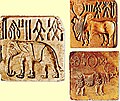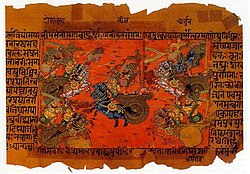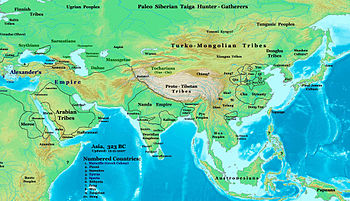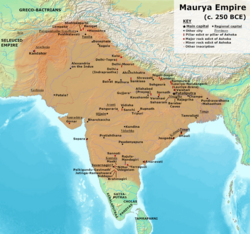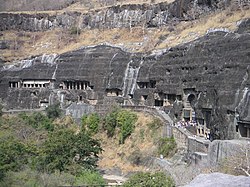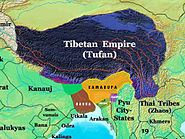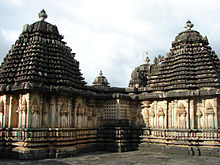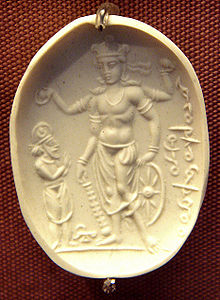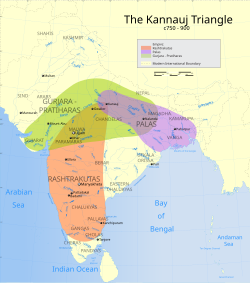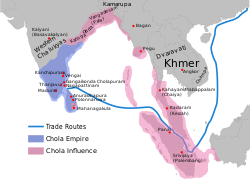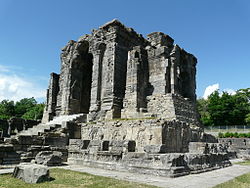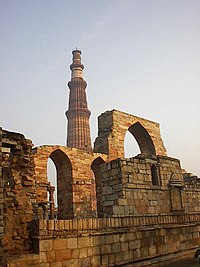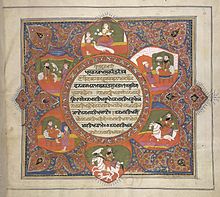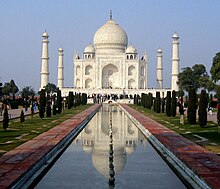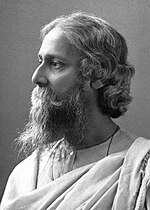Isolated remains of
Homo erectus in Hathnora in the
Narmada Valley in central India indicate that India might have been inhabited since at least the
Middle Pleistocene era, somewhere between 500,000 and 200,000 years ago.
[29][30] Tools crafted by proto-humans that have been dated back two million years have been discovered in the northwestern part of the subcontinent.
[31][32] The ancient history of the region includes some of South Asia's oldest settlements
[33] and some of its major civilisations.
[34][35]
The
Mesolithic period in the Indian subcontinent was followed by the
Neolithic period, when more extensive settlement of the subcontinent occurred after the end of the last
Ice Age approximately 12,000 years ago. The first confirmed semipermanent settlements appeared 9,000 years ago in the
Bhimbetka rock shelters in modern
Madhya Pradesh, India.
Traces of a Neolithic culture have been alleged to be submerged in the
Gulf of Khambat in India,
radiocarbon dated to 7500 BCE.
[48] Neolithic agricultural cultures sprang up in the Indus Valley region around 5000 BCE, in the lower Gangetic valley around 3000 BCE, and in later South India, spreading southwards and also northwards into
Malwaaround 1800 BCE. The first urban civilisation of the region began with the
Indus Valley Civilisation.
Indus Valley Civilisation
- Indus Valley Civilisation
|
|
|
-
Dholavira, one of the largest cities of Indus Valley Civilisation.
|
The civilisation was primarily located in modern-day India (
Gujarat,
Haryana,
Punjab and
Rajasthan provinces) and Pakistan (
Sindh,
Punjab, and
Balochistan provinces). Historically part of
Ancient India, it is one of the world's earliest urban civilisations, along with Mesopotamia and Ancient Egypt.
[59] Inhabitants of the ancient Indus river valley, the Harappans, developed new techniques in metallurgy and handicraft (carneol products, seal carving), and produced copper, bronze, lead, and tin.
The Mature Indus civilisation flourished from about 2600 to 1900 BCE, marking the beginning of urban civilisation on the subcontinent. The civilisation included urban centres such as
Dholavira,
Kalibangan,
Ropar,
Rakhigarhi, and
Lothalin modern-day India, as well as
Harappa,
Ganeriwala, and
Mohenjo-daro in modern-day Pakistan. The civilisation is noted for its cities built of brick, roadside drainage system, and multistoreyed houses and is thought to have had some kind of municipal organisation.
[60]
During the
late period of this civilisation, signs of a
gradual decline began to emerge, and by around 1700 BCE, most of the cities were abandoned. However, the Indus Valley Civilisation did not disappear suddenly, and some elements of the Indus Civilisation may have survived, especially in the smaller villages and isolated farms. The Indian
Copper Hoard Culture is attributed to this time, associated in the Doab region with the
Ochre Coloured Pottery.
Vedic period (c. 1750 BCE–600 BCE)
| [show]Spread of IE-languages |
|---|
| [show]Indo-Aryan migration |
|---|
The
Vedic period is named after the
Indo-Aryan culture of north-west India, although other parts of India had a distinct cultural identity during this period. The Vedic culture is described in the texts of
Vedas, still sacred to Hindus, which were orally composed in
Vedic Sanskrit. The Vedas are some of the oldest extant texts in India. The Vedic period, lasting from about 1750 to 500 BCE,
[62][63] contributed the foundations of several cultural aspects of the Indian subcontinent. In terms of culture, many regions of the subcontinent transitioned from the
Chalcolithic to the
Iron Age in this period.
[64]
Vedic society

A steel engraving from the 1850s, which depicts the creative activities of
Prajapati, a Vedic deity who presides over procreation and protection of life.
Historians have analysed the Vedas to posit a Vedic culture in the
Punjab region and the upper
Gangetic Plain.
[64] Most historians also consider this period to have encompassed several waves of
Indo-Aryan migration into the subcontinent from the north-west.
[65][66] The
peepal tree and cow were sanctified by the time of the
Atharva Veda.
[67] Many of the concepts of Indian philosophy espoused later like Dharma, Karma etc. trace their root to the Vedas.
[68]
Early Vedic society is described in the
Rigveda, the oldest Vedic text, believed to have been compiled during 2nd millennium BCE,
[69][70] in the northwestern region of the Indian subcontinent.
[71] At this time, Aryan society consisted of largely tribal and pastoral groups, distinct from the Harappan urbanisation which had been abandoned.
[72]The early Indo-Aryan presence probably corresponds, in part, to the
Ochre Coloured Pottery culture in archaeological contexts.
[74]
At the end of the Rigvedic period, the Aryan society began to expand from the northwestern region of the Indian subcontinent, into the western
Ganges plain. It became increasingly agricultural and was socially organised around the hierarchy of the four
varnas, or social classes. This social structure was characterised both by syncretising with the native cultures of northern India, but also eventually by the excluding of indigenous peoples by labelling their occupations impure.
[76] During this period, many of the previous small tribal units and chiefdoms began to coalesce into
monarchical, state-level polities.
Sanskritisation
Since Vedic times,
[78][note 2] "people from many strata of society throughout the subcontinent tended to adapt their religious and social life to Brahmanic norms", a process sometimes called
Sanskritisation.
[78] It is reflected in the tendency to identify local deities with the gods of the Sanskrit texts.
[78]
The
Kuru kingdom was the first state-level society of the Vedic period, corresponding to the beginning of the Iron Age in northwestern India, around 1200 – 800 BCE,
[79] as well as with the composition of the
Atharvaveda (the first Indian text to mention iron, as
śyāma ayas, literally "black metal").
[80] The Kuru state organised the Vedic hymns into collections, and developed the orthodox
srauta ritual to uphold the social
ORDER
.
[81] When the Kuru kingdom declined, the centre of Vedic culture shifted to their eastern neighbours, the
Panchala kingdom.
[81] The archaeological
Painted Grey Ware culture, which flourished in the
Haryana and western
Uttar Pradesh regions of northern India from about 1100 to 600 BCE, is believed to correspond to the
Kuru and Panchala kingdoms.
[81]
During the Late Vedic Period, the kingdom of
Videha emerged as a new centre of Vedic culture, situated even farther to the East (in what is today Nepal and
Bihar state in India).
[74] The later part of this period corresponds with a consolidation of increasingly large states and kingdoms, called
mahajanapadas, all across Northern India.
Sanskrit Epics
In addition to the Vedas, the principal texts of Hinduism, the core themes of the Sanskrit epics
Ramayana and
Mahabharata are said to have their ultimate origins during this period.
[83] The
Mahabharata remains, today, the longest single poem in the world.
[84] Historians formerly postulated an "epic age" as the milieu of these two epic poems, but now recognise that the texts (which are both familiar with each other) went through multiple stages of development over centuries. For instance, the
Mahabharata may have been based on a small-scale conflict (possibly about 1000 BCE) which was eventually "transformed into a gigantic epic war by bards and poets". There is no conclusive proof from archaeology as to whether the specific events of the Mahabharat have any historical basis. The existing texts of these epics are believed to belong to the post-Vedic age, between c. 400 BCE and 400 CE.
[86] Some even attempted to date the events using methods of
archaeoastronomy which have produced, depending on which passages are chosen and how they are interpreted, estimated dates ranging up to mid 2nd millennium BCE.
[87][88]
"Second urbanisation" (c. 600 BCE–200 BCE)
During the time between 800 and 200 BCE the
Shramana-movement formed, from which originated
Jainism and
Buddhism. In the same period the first
Upanishads were written. After 500 BCE, the so-called "Second urbanisation" started, with new urban settlements arising at the Ganges plain, especially the Central Ganges plain. The Central Ganges Plain, where
Magadha gained prominence, forming the base of the
Mauryan Empire, was a distinct cultural area, with new states arising after 500 BC
[web 1] during the so-called "Second urbanisation".
[note 3] It was influenced by the Vedic culture, but differed markedly from the Kuru-Panchala region. It "was the area of the earliest known cultivation of rice in South Asia and by 1800 BC was the location of an advanced neolithic population associated with the sites of Chirand and Chechar". In this region the
Shramanic movements flourished, and Jainism and Buddhism originated.
Mahajanapadas

The
Mahajanapadas were the sixteen most powerful kingdoms and republics of the era, located mainly across the fertile
Indo-Gangetic plains, there were a number of smaller kingdoms stretching the length and breadth of
Ancient India.
In the later Vedic Age, a number of small kingdoms or city states had covered the subcontinent, many mentioned in Vedic, early Buddhist and Jaina literature as far back as 500 BCE. sixteen monarchies and "republics" known as the Mahajanapadas—
Kashi,
Kosala,
Anga,
Magadha,
Vajji (or Vriji),
Malla,
Chedi,
Vatsa (or Vamsa),
Kuru,
Panchala,
Matsya (or Machcha),
Shurasena,
Assaka,
Avanti,
Gandhara, and
Kamboja—stretched across the
Indo-Gangetic Plain from modern-day Afghanistan to
Bengal and
Maharashtra. This period saw the second major rise of urbanism in India after the
Indus Valley Civilisation.
Many smaller clans mentioned within early literature seem to have been present across the rest of the subcontinent. Some of these kings were hereditary; other states elected their rulers. Early "republics" such as the Vajji (or Vriji) confederation centred in the city of
Vaishali, existed as early as the 6th century BCE and persisted in some areas until the 4th century CE. The educated speech at that time was
Sanskrit, while the languages of the general population of northern India are referred to as
Prakrits. Many of the sixteen kingdoms had coalesced to four major ones by 500/400 BCE, by the time of
Gautama Buddha. These four were Vatsa, Avanti, Kosala, and Magadha. The Life of Gautam Budhha was mainly associated with these four kingdoms.
Upanishads and Shramana movements
The 7th and 6th centuries BC witnessed the composition of the earliest Upanishads.
[95][96] Upanishads form the theoretical basis of classical Hinduism and are known as
Vedanta (conclusion of the
Vedas).
[97] The older Upanishads launched attacks of increasing intensity on the ritual. Anyone who worships a divinity other than the Self is called a domestic animal of the gods in the Brihadaranyaka Upanishad. The Mundaka launches the most scathing attack on the ritual by comparing those who value sacrifice with an unsafe boat that is endlessly overtaken by old age and death.
[98]
Increasing urbanisation of India in 7th and 6th centuries BCE led to the rise of new ascetic or shramana movements which challenged the orthodoxy of rituals.
[95] Mahavira (c. 549–477 BC), proponent of
Jainism, and
Gautama Buddha (c. 563-483), founder of Buddhism were the most prominent icons of this movement. Shramana gave rise to the concept of the cycle of birth and death, the concept of
samsara, and the concept of liberation.
[99] Buddha found a
Middle Way that ameliorated the extreme
asceticism found in the
Sramana religions.
[100]
Around the same time,
Mahavira (the 24th
Tirthankara in Jainism) propagated a theology that was to later become Jainism.
[101] However, Jain orthodoxy believes the teachings of the Tirthankaras predates all known time and scholars believe
Parshvanath, accorded status as the 23rd Tirthankara, was a historical figure. Rishabhdeo was the 1st Tirthankara. The Vedas are believed to have documented a few Tirthankaras and an ascetic
ORDER
similar to the shramana movement.
[102]
Magadha dynasties

The Magadha state c. 600 BCE, before it expanded from its capital
Rajagriha.
Magadha (
Sanskrit:
मगध) formed one of the sixteen
Mahā-Janapadas (
Sanskrit: "Great Countries") or
kingdoms in ancient India. The core of the kingdom was the area of
Bihar south of the
Ganges; its first capital was
Rajagriha (modern Rajgir) then
Pataliputra (modern
Patna). Magadha expanded to include most of Bihar and
Bengal with the conquest of
Licchavi and
Anga respectively,
[103] followed by much of eastern Uttar Pradesh and Orissa. The ancient kingdom of Magadha is heavily mentioned in
Jain and Buddhist texts. It is also mentioned in the
Ramayana,
Mahabharata,
Puranas.
[104] The earliest reference to the Magadha people occurs in the
Atharva-Veda where they are found listed along with the
Angas,
Gandharis, and Mujavats. Magadha played an important role in the development of
Jainism and Buddhism, and two of India's greatest empires, the
Maurya Empire and
Gupta Empire, originated from Magadha. These empires saw advancements in ancient India's science, mathematics,
astronomy, religion, and philosophy and were considered the Indian "
Golden Age". The Magadha kingdom included republican communities such as the community of Rajakumara. Villages had their own assemblies under their local chiefs called Gramakas. Their administrations were divided into executive, judicial, and military functions.
The Haryanka dynasty was overthrown by the
Shishunaga dynasty. The last Shishunaga ruler, Kalasoka, was assassinated by
Mahapadma Nanda in 345 BCE, the first of the so-called Nine Nandas, Mahapadma and his eight sons.
Persian and Greek conquests in Northwestern South Asia
In 530 BC
Cyrus the Great, King of the Persian
Achaemenid Empire crossed the Hindu-Kush mountains to seek tribute from the tribes of Kamboja, Gandhara and the trans-India region (modern Afghanistan and Pakistan).
[106] By 520 BC, during the reign of Darius I of Persia, much of the northwestern subcontinent (present-day eastern Afghanistan and Pakistan) came under the rule of the Persian Achaemenid Empire, as part of the far easternmost territories. The area remained under Persian control for two centuries.
[107] During this time India supplied mercenaries to the Persian army then fighting in Greece.
[106]
Under Persian rule the famous city of
Takshashila became a centre where both Vedic and Iranian learning were mingled.
[108] Persian ascendency in Northwestern South Asia ended with
Alexander the Great's conquest of Persia in 327 BC.
[109]
By 326 BC, Alexander the Great had conquered Asia Minor and the Achaemenid Empire and had reached the northwest frontiers of the Indian subcontinent. There he defeated
King Porus in the
Battle of the Hydaspes (near modern-day
Jhelum, Pakistan) and conquered much of the
Punjab.
[110]Alexander's march east put him in confrontation with the
Nanda Empire of
Magadha and the
Gangaridai of
Bengal. His army, exhausted and frightened by the prospect of facing larger Indian armies at the Ganges River, mutinied at the Hyphasis (modern
Beas River) and refused to march further East. Alexander, after the meeting with his officer,
Coenus, and learning about the might of
Nanda Empire, was convinced that it was better to return.
The Persian and Greek invasions had repercussions in the Northwestern regions of the Indian subcontinent. The region of Gandhara, or present-day eastern Afghanistan and northwest Pakistan, became a melting pot of Indian, Persian, Central Asian, and Greek cultures and gave rise to a
HYBRID
culture,
Greco-Buddhism, which lasted until the 5th century AD and influenced the artistic development of
Mahayana Buddhism.
Maurya Empire
The Maurya Empire (322–185 BCE) was the first empire to unify India into one state, and was the largest on the Indian subcontinent. At its greatest extent, the Mauryan Empire stretched to the north up to the natural boundaries of the
Himalayas and to the east into what is now
Assam. To the west, it reached beyond modern Pakistan, to the
Hindu Kush mountains in what is now Afghanistan. The empire was established by
Chandragupta Maurya assisted by Chanakya (
Kautilya) in
Magadha (in modern
Bihar) when he overthrew the
Nanda Dynasty.
[111] Chandragupta's son
Bindusara succeeded to the throne around 297 BC. By the time he died in c. 272 BC, a large part of the subcontinent was under Mauryan suzerainty. However, the region of
Kalinga (around modern day
Odisha) remained outside Mauryan control, perhaps interfering with their trade with the south.
Bindusara was succeeded by
Ashoka, whose reign lasted for around thirty seven years until his death in about 232 BCE. His campaign against the Kalingans in about 260 BCE, though successful, lead to immense loss of life and misery. This filled Ashoka with remorse and lead him to shun violence, and subsequently to embrace Buddhism. The empire began to decline after his death and the last Mauryan ruler,
Brihadratha, was assassinated by
Pushyamitra Shunga to establish the
Shunga Empire.
The
Arthashastra and the
Edicts of Ashoka are the primary written records of the Mauryan times. Archaeologically, this period falls into the era of
Northern Black Polished Ware (NBPW). The Mauryan Empire was based on a modern and efficient economy and society. However, the
SALE
of merchandise was closely regulated by the government.
[114] Although there was no banking in the Mauryan society, usury was customary. A significant amount of written records on slavery are found, suggesting a prevalence thereof. During this period, a high quality steel called
Wootz steel was developed in south India and was later exported to China and Arabia.
[13]
Sangam Period
The Sangam literature
DEALS
with the history, politics, wars and culture of the Tamil people of this period.
[117] The scholars of the Sangam period rose from among the common people who sought the patronage of the Tamil Kings, but who mainly wrote about the common people and their concerns.
[118] Unlike Sanskrit writers who were mostly Brahmins, Sangam writers came from diverse classes and social backgrounds and were mostly non-Brahmins. They belonged to different faiths and professions like farmers, artisans, merchants, monks, priests and even princes and quite few of them were even
WOMEN
.
[118]
Classical period (c. 200 BCE–1200 CE)
The time between 200 BCE and ca. 1100 CE is the "Classical Age" of India. It can be divided in various sub-periods, depending on the chosen periodisation. Classical period begins after the decline of the
Maurya Empire, and the corresponding rise of the
Satavahana dynasty, beginning with
Simuka, from 230 BCE. The
Gupta Empire (4th–6th century) is regarded as the "Golden Age" of Hinduism, although a host of kingdoms ruled over India in these centuries. Also, the
Sangam literature flourished from the 3rd century BCE to the 3rd century CE in southern India.
[12] During this period, India is estimated to have had the largest economy in the world; controlling between one third and one fourth of the world's wealth.
[119][120]
Early Classical period (c. 200 BCE–320 CE)
Satavahana Dynasty

Reliefs depicting life of Buddha, Satavhana Dynasty, 3rd century BC.
The
Śātavāhana Empire was a royal Indian dynasty based from
Amaravati in
Andhra Pradesh as well as
Junnar (
Pune) and Prathisthan (
Paithan) in
Maharashtra. The territory of the empire covered much of India from 230 BCE onward. Sātavāhanas started out as feudatories to the
Mauryan dynasty, but declared independence with its decline. They are known for their patronage of Hinduism and Buddhism which resulted in Buddhist monuments from
Ellora (a
UNESCO World Heritage Site) to
Amaravati. The Sātavāhanas were one of the first Indian states to issue coins struck with their rulers embossed. They formed a cultural bridge and played a vital role in trade as well as the transfer of ideas and culture to and from the
Indo-Gangetic Plain to the southern tip of India. They had to compete with the
Shunga Empire and then the
Kanva dynasty of
Magadha to establish their rule. Later, they played a crucial role to protect a huge part of India against foreign invaders like the
Sakas,
Yavanas and
Pahlavas. In particular their struggles with the
Western Kshatrapas went on for a long time. The notable rulers of the Satavahana Dynasty
Gautamiputra Satakarni and
Sri Yajna Sātakarni were able to defeat the foreign invaders like the
Western Kshatrapas and to stop their expansion. In the 3rd century CE the empire was split into smaller states.
Shunga Empire
The Shunga Empire was an ancient Indian dynasty from
Magadha that controlled vast areas of the Indian subcontinent from around 187 to 78 BCE. The dynasty was established by
Pushyamitra Shunga, after the fall of the
Maurya Empire. Its capital was
Pataliputra, but later emperors such as
Bhagabhadra also held court at
Besnagar, modern
Vidisha in Eastern
Malwa.
[121] Pushyamitra Shunga ruled for 36 years and was succeeded by his son
Agnimitra. There were ten Shunga rulers. The empire is noted for its numerous wars with both foreign and indigenous powers. They fought battles with the
Kalingas,
Satavahanas, the
Indo-Greeks, and possibly the
Panchalas and
Mathuras. Art, education, philosophy, and other forms of learning flowered during this period including small terracotta images, larger stone sculptures, and architectural monuments such as the Stupa at
Bharhut, and the renowned Great Stupa at
Sanchi. The Shunga rulers helped to establish the tradition of royal sponsorship of learning and art. The script used by the empire was a variant of
Brahmi and was used to write the
Sanskrit language. The Shunga Empire played an imperative role in patronising
Indian culture at a time when some of the most important developments in Hindu thought were taking place. This helped the empire flourish and gain power.
Mahameghavahana Empire
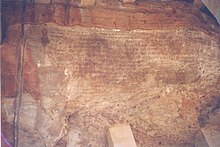
The Hathigumpha inscription of Kharavela
Kaḷingan military might was reinstated by Khārabēḷa: under Khārabēḷa's generalship, the Kaḷinga state had a formidable maritime reach with trade routes linking it to the then-Simhala (Sri Lanka), Burma (Myanmar), Siam (Thailand), Vietnam, Kamboja (Cambodia), Malaysia, Borneo, Bali, Samudra (Sumatra) and Jabadwipa (Java). Khārabēḷa led many successful campaigns against the states of Magadha, Anga, Satavahanas till the southern most regions of Pandyan Empire (modern Tamil Nadu).
The empire was a maritime power with trading routes linking it to Sri Lanka, Burma, Thailand, Vietnam, Cambodia,
Borneo,
Bali,
Sumatra, and
Java. Colonists from Kalinga settled in Sri Lanka, Burma, as well as the Maldives and
Maritime Southeast Asia.
Northwestern kingdoms and hybrid cultures
The Northwestern kingdoms and
HYBRID
cultures of the Indian subcontinent included the
Indo-Greeks, the
Indo-Scythians, the
Indo-Parthians, and the
Indo-Sassinids.
- Indo-Greek Kingdom: The Indo-Greek Menander I (reigned 155–130 BCE) drove the Greco-Bactrians out of Gandhara and beyond the Hindu Kush, becoming a king shortly after his victory. His territories covered Panjshir and Kapisa in modern Afghanistan and extended to the Punjab region, with many tributaries to the south and east. The capital Sagala (modern Sialkot) prospered greatly under Menander's rule.[123] The classical Buddhist text Milinda Pañha praises Menander, saying there was "none equal to Milinda in all India".[124] Lasting for almost two centuries, the kingdom was ruled by a succession of more than 30 Indo-Greek kings, who were often in conflict with each other.
- Indo-Scythian Kingdom: The Indo-Scythians were descended from the Sakas (Scythians) who migrated from southern Siberia to Pakistan and Arachosia to India from the middle of the 2nd century BCE to the 1st century BCE. They displaced the Indo-Greeks and ruled a kingdom that stretched from Gandhara to Mathura. The power of the Saka rulers started to decline in the 2nd century CE after the Scythians were defeated by the south Indian Emperor Gautamiputra Satakarni of the Satavahana dynasty.[125]Later the Saka kingdom was completely destroyed by Chandragupta II of the Gupta Empire from eastern India in the 4th century.[127]
- Indo-Parthian Kingdom: The Indo-Parthian Kingdom was ruled by the Gondopharid dynasty, named after its eponymous first ruler Gondophares. They ruled parts of present-day Afghanistan, Pakistan, and northwestern India,[128] during or slightly before the 1st century AD. For most of their history, the leading Gondopharid kings held Taxila(in the present Punjab province of Pakistan) as their residence and ruled from there, but during their last few years of existence the capital shifted between Kabul andPeshawar. These kings have traditionally been referred to as Indo-Parthians, as their coinage was often inspired by the Arsacid dynasty, but they probably belonged to a wider groups of Iranian tribes who lived east of Parthia proper, and there is no evidence that all the kings who assumed the title Gondophares, which means "Holder of Glory", were even related.
- Indo-Sassanid Kingdom: The Sassanid empire of Persia, who was contemporaneous with the Gupta Empire, expanded into the region of present-day Balochistan in Pakistan, where the mingling of Indian culture and the culture of Iran gave birth to aHYBRID
 culture under the Indo-Sassanids.
culture under the Indo-Sassanids.
Trade and Travels to India

Silk Road and
Spice trade, ancient trade routes that linked India with the
Old World; carried goods and ideas between the ancient civilisations of the Old World and India. The land routes are red, and the water routes are blue.
The
spice trade in
Kerala attracted traders from all over the Old World to India. Early writings and Stone Age carvings of
neolithic age obtained indicates that India's Southwest coastal port
Muziris, in Kerala, had established itself as a major spice trade centre from as early as 3,000 BCE, according to
Sumerian records. Kerala was referred to as the land of spices or as the "Spice Garden of India". It was the place traders and exporters wanted to reach, including
Christopher Colombus,
Vasco da Gama, and others.
[129]
Buddhism entered China through the
Silk Road transmission of Buddhism in the 1st or 2nd century CE. The interaction of cultures resulted in several Chinese travellers and monks to enter India. Most notable were
Faxian,
Yijing,
Song Yun and
Xuanzang. These travellers wrote detailed accounts of the Indian Subcontinent, which includes the political and social aspects of the region.
[130]
Hindu and Buddhist religious establishments of Southeast Asia came to be associated with the economic activity and commerce as patrons entrust large funds which would later be used to benefit local economy by estate management, craftsmanship,
PROMOTION
of trading activities. Buddhism in particular, travelled alongside the maritime trade, promoting coinage, art and literacy.
[131] Indian merchants involved in spice trade took
Indian cuisine to Southeast Asia, where spice mixtures and
curries became popular with the native inhabitants.
[132]
Strabo, whose
Geography is the main surviving source of the story, was sceptical about its truth. Modern scholarship tends to consider it relatively credible. During the 2nd century BC Greek and Indian ships met to trade at
Arabian ports such as
Aden (called
Eudaemon by the Greeks).
[135] Another Greek navigator,
Hippalus, is sometimes credited with discovering the monsoon wind route to India. He is sometimes conjectured to have been part of Eudoxus's expeditions.
[136]
Kushan Empire

Kushan territories (full line) and maximum extent of Kushan dominions under Kanishka (dotted line), according to the Rabatak inscription.
Emperor Kanishka was a great patron of
Buddhism; however, as Kushans expanded southward, the deities
[141] of their later coinage came to reflect its new
Hindu majority.
[142]
They played an important role in the establishment of Buddhism in India and its spread to Central Asia and China.
He played the part of a second Ashoka in the history of Buddhism.
[143]
The empire linked the Indian Ocean maritime trade with the commerce of the
Silk Road through the Indus valley, encouraging long-distance trade, particularly between China and
Rome. The Kushans brought new trends to the budding and blossoming
Gandhara Art, which reached its peak during Kushan Rule.
H.G. Rowlinson commented:
The Kushan period is a fitting prelude to the Age of the Guptas.
[144]
By the 3rd century, their empire in India was disintegrating and their last known great emperor was
Vasudeva I.
[145][146]
Classical period (c. 320-650 CE)
Gupta Empire - Golden Age
Classical India refers to the period when much of the Indian subcontinent was reunited under the Gupta Empire (c. 320–550 CE).
[147][148] This period has been called the Golden Age of India
[149] and was marked by extensive achievements in
science, technology,
engineering,
art,
dialectic,
literature,
logic,
mathematics,
astronomy,
religion, and
philosophythat crystallised the elements of what is generally known as
Hindu culture.
[150] The
Hindu-Arabic numerals, a
positional numeral system, originated in India and was later transmitted to the West through the Arabs. Early Hindu numerals had only nine symbols, until 600 to 800 CE, when a symbol for zero was developed for the numeral system.
[151]The peace and prosperity created under leadership of Guptas enabled the pursuit of scientific and artistic endeavours in India.
[152]
The high points of this cultural creativity are magnificent architecture, sculpture, and painting.
[153] The Gupta period produced scholars such as
Kalidasa,
Aryabhata,
Varahamihira,
Vishnu Sharma, and
Vatsyayana who made great advancements in many academic fields.
[154] The Gupta period marked a watershed of Indian culture: the Guptas performed Vedic sacrifices to legitimise their rule, but they also patronised Buddhism, which continued to provide an alternative to Brahmanical orthodoxy. The military exploits of the first three rulers –
Chandragupta I,
Samudragupta, and
Chandragupta II - brought much of India under their leadership.
[155] Science and political administration reached new heights during the Gupta era. Strong trade ties also made the region an important cultural centre and established it as a base that would influence nearby kingdoms and regions in Burma, Sri Lanka,
Maritime Southeast Asia, and
Indochina.
Historian Dr. Barnett remarked:
However, some historians like
D.N.Jha disagree:
The much published Hindu renaissance was, in reality, not a renaissance, much less a Hindu one.
[157]
The latter Guptas successfully resisted the northwestern kingdoms until the arrival of the
Hunas, who established themselves in Afghanistan by the first half of the 5th century, with their capital at
Bamiyan.
[158] However, much of the
Deccan and southern India were largely unaffected by these events in the north.
[159][160]
Vakataka Dynasty
The Vākāṭaka Empire (
Marathi:
वाकाटक) was a royal Indian
dynasty that originated from the
Deccan in the mid-third century CE. Their state is believed to have extended from the southern edges of
Malwa and
Gujarat in the north to the
Tungabhadra River in the south as well as from the
Arabian Sea in the western to the edges of
Chhattisgarh in the east. They were the most important successors of the
Satavahanas in the
Deccan and contemporaneous with the
Guptas in northern India.
The Vakatakas are noted for having been patrons of the arts, architecture and literature. They led public works and their monuments are a visible legacy. The rock-cut Buddhist viharas and chaityas of
Ajanta Caves (a
UNESCO World Heritage Site) were built under the patronage of Vakataka emperor,
Harishena.
[161][162]
Kamarupa Kingdom
Davaka was later absorbed by Kamarupa, which grew into a large kingdom that spanned from Karatoya river to near present
Sadiya and covered the entire Brahmaputra valley,
North Bengal, parts of
Bangladesh and, at times
Purnea and parts of
West Bengal.
[165]
In the reign of the Varman king,
Bhaskar Varman (c. 600–650 AD), the Chinese traveller
Xuanzang visited the
region and recorded his travels. Later, after weakening and disintegration (after the Kamarupa-Palas), the Kamarupa tradition was somewhat extended till c. 1255 AD by the Lunar I (c. 1120–1185 AD) and Lunar II (c. 1155–1255 AD) dynasties.
[167]
Pallava Dynasty
The
Pallavas, during the 4th to 9th centuries were, alongside the
Guptas of the
North, great patronisers of Sanskrit development in the
South of the
Indian subcontinent. The Pallava reign saw the first Sankrit inscriptions in a script called
Grantha.
[168] Early Pallavas had different connexions to
Southeast Asian countries. The Pallavas used Dravidian architecture to build some very important Hindu temples and academies in
Mamallapuram,
Kanchipuram and other places; their rule saw the rise of great poets. The practice of dedicating temples to different deities came into vogue followed by fine artistic
temple architecture and sculpture style of
Vastu Shastra.
[169]
Kadamba Dynasty
Kadamba (345 – 525 CE) was an ancient royal dynasty of
Karnataka, India that ruled northern Karnataka and the Konkan from
Banavasiin present-day
Uttara Kannada district. At the peak of their power under King Kakushtavarma, the Kadambas of Banavasi ruled large parts of modern Karnataka state.
The dynasty was founded by
Mayurasharma in 345 CE which at later times showed the potential of developing into imperial proportions, an indication to which is provided by the titles and epithets assumed by its rulers. King Mayurasharma defeated the armies of
Pallavas of Kanchi possibly with help of some native tribes. The Kadamba fame reached its peak during the rule of
Kakusthavarma, a notable ruler with whom even the kings of
Gupta Dynasty of northern India cultivated marital alliances. The Kadambas were contemporaries of the
Western Ganga Dynasty and together they formed the earliest native kingdoms to rule the land with absolute autonomy. The dynasty later continued to rule as a feudatory of larger Kannada empires, the
Chalukya and the
Rashtrakuta empires, for over five hundred years during which time they branched into minor dynasties known as the
Kadambas of Goa,
Kadambas of Halasi and
Kadambas of Hangal.
The White Huns
The Hephthalites (or Ephthalites), also known as the White Huns, were a nomadic confederation in Central Asia during the late antiquity period. The
White Huns established themselves in modern-day Afghanistan by the first half of the 5th century. Led by the Hun military leader
Toramana, they overran the northern region of Pakistan and North India. Toramana's son
Mihirakula, a
Saivite Hindu, moved up to near
Pataliputra to the east and
Gwalior to the central India.
Hiuen Tsiang narrates Mihirakula's merciless persecution of Buddhists and destruction of monasteries, though the description is disputed as far as the authenticity is concerned.
[171] The Huns were defeated by the Indian kings
Yasodharman of Malwa and Narasimhagupta in the 6th century. Some of them were driven out of India and others were assimilated in the Indian society.
[172]
Empire of Harsha
After the downfall of the prior
Gupta Empire in the middle of the 6th century,
North India reverted to small republics and small monarchical states ruled by Gupta rulers. Harsha was a
CONVERT
to Buddhism.
[173] He united the small republics from Punjab to central India, and their representatives crowned Harsha king at an assembly in April 606 giving him the title of Maharaja when he was merely 16 years old. Harsha belonged to Kanojia.
[174] He brought all of northern India under his control.
[175] The peace and prosperity that prevailed made his court a centre of cosmopolitanism, attracting scholars, artists and religious visitors from far and wide.
[175] The Chinese traveller Xuan Zang visited the court of Harsha and wrote a very favourable account of him, praising his justice and generosity.
[175]
Late Classical period (c. 650–1200 CE)
From the fifth century to the thirteenth,
Śrauta sacrifices declined, and initiatory traditions of
Buddhism,
Jainism or more commonly
Shaivism,
Vaishnavism and
Shaktismexpanded in royal courts.
[3] This period produced some of India's finest art, considered the epitome of classical development, and the development of the main spiritual and philosophical systems which continued to be in Hinduism, Buddhism and Jainism.
North-Western Indian Buddhism weakened in the 6th century after the
White Hun invasion, who followed their own religions at the beginning such as
Tengri, but later
Indian religions.
Muhammad bin Qasim's invasion of
Sindh (modern Pakistan) in 711 CE witnessed further decline of Buddhism. The
Chach Nama records many instances of conversion of stupas to mosques such as at
Nerun.
[178]
In the 7th century CE,
Kumārila Bhaṭṭa formulated his school of
Mimamsa philosophy and defended the position on Vedic rituals against Buddhist attacks. Scholars note Bhaṭṭa's contribution to the
decline of Buddhism in India.
[179] His dialectical success against the Buddhists is confirmed by Buddhist historian
Tathagata, who reports that Kumārila defeated disciples of Buddhapalkita, Bhavya, Dharmadasa, Dignaga and others.
[180]
In the 8th century,
Adi Shankara travelled across the Indian subcontinent to propagate and spread the doctrine of
Advaita Vedanta, which he consolidated; and is credited with unifying the main characteristics of the current thoughts in Hinduism.
[181][182][183] He was a critic of both Buddhism and Minamsa school of Hinduism;
[184][185][186][187]and founded
mathas (monasteries), in the four corners of the Indian subcontinent for the spread and development of Advaita Vedanta.
[188]
Ronald Inden writes that by the 8th century CE symbols of Hindu gods "replaced the Buddha at the imperial centre and pinnacle of the cosmo-political system, the image or symbol of the Hindu god comes to be housed in a monumental temple and given increasingly elaborate imperial-style puja worship".
[189] Although Buddhism did not disappear from India for several centuries after the eighth, royal proclivities for the cults of Vishnu and Shiva weakened Buddhism's position within the sociopolitical context and helped make possible its decline.
[190]
Emperor Harsha of
Kannauj succeeded in reuniting northern India during his reign in the 7th century, after the collapse of the Gupta dynasty. His empire collapsed after his death.
From the 8th to the 10th century, three dynasties contested for control of northern India: the
Gurjara Pratiharas of Malwa, the
Palas of Bengal, and the
Rashtrakutas of the Deccan. The
Sena dynasty would later assume control of the Pala Empire, and the Gurjara Pratiharas fragmented into various states. These were the first of the
Rajputstates. The first recorded
Rajput kingdoms emerged in
Rajasthan in the 6th century, and small Rajput dynasties later ruled much of northern India. One
Gurjar[191][192]Rajput of the
Chauhan clan,
Prithvi Raj Chauhan, was known for bloody conflicts against the advancing Turkic sultanates.
Chalukya Empire
The
Chalukya Empire (
Kannada:
ಚಾಲುಕ್ಯರು [tʃaːɭukjə]) was an Indian royal dynasty that ruled large parts of
southern and
central India between the 6th and the 12th centuries. During this period, they ruled as three related yet individual dynasties. The earliest dynasty, known as the "Badami Chalukyas", ruled from Vatapi (modern
Badami) from the middle of the 6th century. The Badami Chalukyas began to assert their independence at the decline of the
Kadamba kingdom of
Banavasi and rapidly rose to prominence during the reign of
Pulakeshin II. The rule of the Chalukyas marks an important milestone in the history of
South India and a golden age in the history of
Karnataka. The political atmosphere in South India shifted from smaller kingdoms to large empires with the ascendancy of Badami Chalukyas. A Southern India-based kingdom took control and consolidated the entire region between the
Kaveri and the
Narmada rivers. The rise of this empire saw the birth of efficient administration, overseas trade and commerce and the development of new style of architecture called "Chalukyan architecture". The
Chalukya dynasty ruled parts of southern and central India from Badami in Karnataka between 550 and 750, and then again from
Kalyani between 970 and 1190.
The
Solanki dynasty of Gujarat were a branch of the Chalukyas. Their capital at Anhilwara (modern
Patan, Gujarat) was one of the largest cities in Classical India, with population estimated at 100,000 in 1000 CE.
Rashtrakuta Empire
Founded by
Dantidurga around 753, the Rashtrakuta Empire ruled from its capital at
Manyakheta for almost two centuries.
[198]At its peak, the Rashtrakutas ruled from the Ganges River and Yamuna River doab in the north to Cape Comorin in the south, a fruitful time of political expansion, architectural achievements and famous literary contributions.
[199][200]
The early rulers of this dynasty were Hindu, but the later rulers were strongly influenced by Jainism.
Govinda III and
Amoghavarsha were the most famous of the long line of able administrators produced by the dynasty. Amoghavarsha, who ruled for 64 years, was also an author and wrote
Kavirajamarga, the earliest known Kannada work on poetics.
[198] Architecture reached a milestone in the Dravidian style, the finest example of which is seen in the Kailasanath Temple at Ellora. Other important contributions are the sculptures of Elephanta Caves in modern Maharashtra as well as the Kashivishvanatha temple and the Jain Narayana temple at Pattadakal in modern Karnataka, all of which are UNESCO World Heritage Sites.
The Arab traveller Suleiman described the Rashtrakuta Empire as one of the four great Empires of the world. The Rashtrakuta period marked the beginning of the golden age of southern Indian mathematics. The great south Indian mathematician
Mahāvīra lived in the Rashtrakuta Empire and his text had a huge impact on the medieval south Indian mathematicians who lived after him.
[204] The Rashtrakuta rulers also patronised men of letters, who wrote in a variety of languages from Sanskrit to the
Apabhraṃśas.
[198]
Pala Empire
Nalanda is considered one of the first great universities in recorded history. It was the centre of Buddhist learning and research in the world from 450 to 1193 AD. It reached its height under the Palas.
Landscape of
Vikramashila university ruins, the seating and meditation area. Established by Emperor
Dharmapala.
The
Pala Empire (
Bengali:
পাল সাম্রাজ্য Pal Samrajyô) flourished during the Classical period of India, and may be dated during 750–1174 CE. Founded by
Gopala I,
[205][206][207] it was ruled by a Buddhist dynasty from Bengal in the eastern region of the Indian subcontinent. Though the Palas were followers of the Mahayana and Tantric schools of Buddhism,
[208] they also patronised
Shaivism and
Vaishnavism.
[209] The
morpheme Pala, meaning "protector", was used as an ending for the names of all the Pala monarchs. The empire reached its peak under
Dharmapala and
Devapala. Dharmapala is believed to have conquered Kanauj and extended his sway up to the farthest limits of India in the northwest.
[209] The Pala Empire can be considered as the golden era of Bengal in many ways. Dharmapala founded the
Vikramashilaand revived Nalanda,
[209] considered one of the first great universities in recorded history. Nalanda reached its height under the patronage of the Pala Empire.
[211] The Palas also built many
viharas. They maintained close cultural and commercial ties with countries of Southeast Asia and
Tibet. Sea trade added greatly to the prosperity of the Pala kingdom. The Arab merchant Suleiman notes the enormity of the Pala army in his memoirs.
[209]
Chola Empire
Medieval Cholas rose to prominence during the middle of the 9th century C.E. and established the greatest empire South India had seen.
[212] They successfully united the South India under their rule and through their naval strength extended their influence in the Southeast Asian countries such as Srivijaya.
[193] Under
Rajaraja Chola I and his successors
Rajendra Chola I,
Rajadhiraja Chola,
Virarajendra Chola and
Kulothunga Chola I the dynasty became a military, economic and cultural power in South Asia and South-East Asia.
[213][214] Rajendra Chola I's navies went even further, occupying the sea coasts from Burma to Vietnam,
[215] the
Andaman and Nicobar Islands, the
Lakshadweep (Laccadive) islands,
Sumatra, and the
Malay Peninsula in Southeast Asia and the Pegu islands. The power of the new empire was proclaimed to the eastern world by the expedition to the
Ganges which Rajendra Chola I undertook and by the occupation of cities of the maritime empire of
Srivijaya in Southeast Asia, as well as by the repeated embassies to China.
[216]
They dominated the political affairs of Sri Lanka for over two centuries through repeated invasions and occupation. They also had continuing trade contacts with the Arabs in the west and with the Chinese empire in the east.
[217] Rajaraja Chola I and his equally distinguished son Rajendra Chola I gave political unity to the whole of Southern India and established the Chola Empire as a respected sea power.
[218] Under the Cholas, the South India reached new heights of excellence in art, religion and literature. In all of these spheres, the Chola period marked the culmination of movements that had begun in an earlier age under the Pallavas. Monumental architecture in the form of majestic temples and sculpture in stone and bronze reached a finesse never before achieved in India.
[219]
Western Chalukya Empire
The
Western Chalukya Empire (
Kannada:
ಪಶ್ಚಿಮ ಚಾಲುಕ್ಯ ಸಾಮ್ರಾಜ್ಯ) ruled most of the
western Deccan,
South India, between the 10th and 12th centuries.
[220] Vast areas between the
Narmada River in the north and
Kaveri River in the south came under Chalukya control.
[220] During this period the other major ruling families of the Deccan, the
Hoysalas, the
Seuna Yadavas of Devagiri, the
Kakatiya dynasty and the Southern
Kalachuri, were subordinates of the Western Chalukyas and gained their independence only when the power of the Chalukya waned during the later half of the 12th century.
[221] The Western Chalukyas developed an architectural style known today as a transitional style, an architectural link between the style of the early Chalukya dynasty and that of the later Hoysala empire. Most of its monuments are in the districts bordering the Tungabhadra River in central Karnataka. Well known examples are the
Kasivisvesvara Temple at
Lakkundi, the
Mallikarjuna Temple at Kuruvatti, the
Kallesvara Temple at Bagali and the
Mahadeva Temple at Itagi.
[222] This was an important period in the development of fine arts in Southern India, especially in literature as the Western Chalukya kings encouraged writers in the native language of
Kannada, and
Sanskrit like the philosopher and statesman
Basava and the great mathematician
Bhāskara II.
[223][224]
Early Islamic intrusions into the Indian subcontinent
The early Islamic literature indicates that the conquest of the Indian subcontinent was one of the very early ambitions of the Muslims, though it was recognised as a particularly difficult one.
[225] After conquering Persia, the Arab
Umayyad Caliphate incorporated parts of what are now Afghanistan and Pakistan around 720.
In 712, Arab Muslim general Muhammad bin Qasim conquered most of the Indus region in modern-day Pakistan for the Umayyad Empire, incorporating it as the "As-Sindh" province with its capital at Al-Mansurah, 72 km (45 mi) north of modern
Hyderabad in Sindh, Pakistan. After several incursions, the Hindu kings east of Indus defeated the Arabs during the
Caliphate campaigns in India, halting their expansion and containing them at Sindh in Pakistan. The south Indian
Chalukya empire under
Vikramaditya II,
Nagabhata I of the
Pratihara dynasty and
Bappa Rawal of the
Guhilot dynasty repulsed the Arab invaders in the early 8th century.
[226]
Several Islamic kingdoms (
sultanates) under both foreign and, newly converted,
Rajput rulers were established across the Northwestern subcontinent (Afghanistan and Pakistan) over a period of a few centuries. From the 10th century, Sindh was ruled by the Rajput
Soomra dynasty, and later, in the mid-13th century by the Rajput
Samma dynasty. Additionally, Muslim trading communities flourished throughout coastal south India, particularly on the western coast where Muslim traders arrived in small numbers, mainly from the Arabian peninsula. This marked the introduction of a third
Abrahamic Middle Eastern religion, following Judaism and Christianity, often in puritanical form.
Mahmud of Ghazni in the early 11th century raided mainly the north-western parts of the Indian sub-continent 17 times, but he did not seek to establish "permanent dominion" in those areas.
[227]
Hindu Shahi
The Kabul Shahi dynasties ruled the
Kabul Valley and
Gandhara (modern-day Pakistan and
Afghanistan) from the decline of the
Kushan Empire in the 3rd century to the early 9th century.
[228]The Shahis are generally split up into two eras: the
Buddhist Shahis and the
Hindu Shahis, with the change-over thought to have occurred sometime around 870. The kingdom was known as the Kabul Shahan or Ratbelshahan from 565-670, when the capitals were located in
Kapisa and Kabul, and later
Udabhandapura, also known as Hund
[229] for its new capital.
[230][231][232]
The Hindu Shahis under
Jayapala, is known for his struggles in defending his kingdom against the
Ghaznavids in the modern-day eastern
Afghanistan and
Pakistan region. Jayapala saw a danger in the consolidation of the Ghaznavids and invaded their capital city of
Ghazni both in the reign of
Sebuktigin and in that of his son
Mahmud, which initiated the
Muslim Ghaznavid and
Hindu Shahi struggles.
[233] Sebuk Tigin, however, defeated him, and he was forced to pay an indemnity.
[233] Jayapala defaulted on the
PAYMENT
and took to the battlefield once more.
[233]Jayapala however, lost control of the entire region between the
Kabul Valley and
Indus River.
[234]
Before his struggle began Jaipal had raised a large army of Punjabi Hindus. When Jaipal went to the
Punjab region, his army was raised to 100,000 horsemen and an innumerable host of foot soldiers. According to
Ferishta:
The two armies having met on the confines of
Lumghan,
Subooktugeen ascended a hill to
VIEW
the forces of Jeipal, which appeared in extent like the boundless ocean, and in number like the ants or the locusts of the wilderness. But Subooktugeen considered himself as a wolf about to attack a flock of sheep: calling, therefore, his chiefs together, he encouraged them to glory, and issued to each his commands. His soldiers, though few in number, were divided into squadrons of five hundred men each, which were directed to attack successively, one particular point of the Hindoo line, so that it might continually have to encounter fresh troops.
[234]
However, the army was hopeless in battle against the western forces, particularly against the young Mahmud of Ghazni.
[234] In the year 1001, soon after Sultan Mahmud came to power and was occupied with the
Qarakhanids north of the
Hindu Kush, Jaipal
attacked Ghazni once more and upon suffering yet another defeat by the powerful Ghaznavid forces, near present-day
Peshawar. After the
Battle of Peshawar, he committed suicide because his subjects thought he had brought disaster and disgrace to the Shahi dynasty.
[233][234]
Jayapala was succeeded by his son
Anandapala,
[233] who along with other succeeding generations of the Shahiya dynasty took part in various unsuccessful campaigns against the advancing Ghaznvids but were unsuccessful. The Hindu rulers eventually exiled themselves to the
Kashmir Siwalik Hills.
[234]
Medieval and Early Modern periods (c. 1206–1858 CE)
The Medieval and Early Modern periods in India is defined by the disruption to native Indian elites by Muslim Central Asian nomadic clans;leading to the
Rajput resistance to Muslim conquests, and growth of Hindu, Muslim, and Sikh, dynasties and empires, built upon new military technology and techniques; the rise of theistic devotional trend of the
Bhakti movement, the cultural synthesis of Hindu and Muslim elements reflected in
Indo-Islamic architecture; and came to an end with the
British Raj.
Growth of Muslim Population in Medieval India
Like other settled, agrarian societies in history, those in the Indian subcontinent have been attacked by nomadic tribes throughout its long history. In evaluating the impact of Islam on the sub-continent, one must note that the northwestern sub-continent was a frequent target of tribes raiding from Central Asia. In that sense, the Muslim intrusions and later Muslim invasions were not dissimilar to those of the earlier invasions during the 1st millennium.
[238] What does however, make the Muslim intrusions and later Muslim invasions different is that unlike the preceding invaders who assimilated into the prevalent social system, the successful Muslim conquerors retained their Islamic identity and created new legal and administrative systems that challenged and usually in many cases superseded the existing systems of social conduct and ethics, even influencing the non-Muslim rivals and common masses to a large extent, though non-Muslim population was left to their own laws and customs. They also introduced new cultural codes that in some ways were very different from the existing cultural codes. This led to the rise of a new Indian culture which was mixed in nature, though different from both the ancient Indian culture and later westernised modern Indian culture. At the same time it must be noted that overwhelming majority of Muslims in India are Indian natives
CONVERTED
to Islam. This factor also played an important role in the synthesis of cultures.
[239]

The growth of Muslim dynasties also caused destruction and desecration of politically important temples of enemy states,
[240] cases of forced conversions to Islam,
[241]PAYMENT of
jizya tax,
[242] and loss of life for the non-Muslim population.
[243] As noted by Historian
Will Durant:
The Mohammedan conquest of India is probably the bloodiest story in history. The Islamic historians and scholars have recorded with great glee and pride the slaughters of Hindus, forced conversions, abduction of Hindu women and children to slave markets and the destruction of temples carried out by the warriors of Islam during 800 AD to 1700 AD. Millions of Hindus were converted to Islam by sword during this period.
[244]
Rajput resistance to Muslim conquests
Before the Muslim expeditions into the Indian subcontinent, much of North and West India were ruled by
Rajput dynasties. The Rajputs were successful in containing Arab Muslim expansion during the
Caliphate campaigns in India; but, later Central Asian Muslim Turks were able to break through the Rajput defence into the Indian heartland. However, the Rajputs held out against the Muslim Turkic empires for several centuries. They earned a reputation by fighting battles with code of chivalrous conduct rooted in a strong adherence to tradition and Chi.
[245]
- The Rajput Chauhan dynasty established rule over Delhi and Ajmer in the 10th century. The most popular ruler of this dynasty was Prithviraj Chauhan. His reign marked one of the most significant moment in Indian history; his battles with Muslim Sultan Muhammad Ghori. The First Battle of Tarain, Ghori was defeated with heavy losses. However, the Second Battle of Tarain saw the Rajput army eventually defeated, laying the foundation of Muslim rule in mainland India.[246]
- Mewar dynasty under Maharana Hammir defeated Muhammad Tughlaq with Bargujars as his main allies, and captured him. Tughlaq had to pay a huge ransom and relinquish all of Mewar's lands. After this event, the Delhi Sultanate did not attack Chittorgarh for a few hundred years. The Rajputs reestablished their independence, and Rajput states were established as far east as Bengal and north into the Punjab. The Tomaras established themselves at Gwalior, and the ruler Man Singh Tomar built the fortress which still stands there.[247]
- Mewar emerged as the leading Rajput state, and Rana Kumbha expanded his kingdom at the expense of the sultanates of Malwa and Gujarat.[247][248]
- Rana Sanga of Mewar became the principal player in Northern India. His objectives grew in scope – he planned to conquer the much sought after prize of the Muslim rulers of the time, Delhi. However, his defeat in the Battle of Khanwa consolidated the new Mughal dynasty in India.[247]
- Maharana Pratap of Mewar, a 16th-century Rajput ruler firmly resisted the Mughals. Akbar sent many missions against him. He survived to ultimately gain control of all of Mewar, excluding Chittorgarh Fort.[249]
- The Chittorgarh Fort is the largest in India; it is a symbol for Rajput resistance. Chittorgarh Fort was sacked three times between the 15th and 16th centuries by Muslim armies; in 1303 Allauddin Khilji defeated Rana Ratan Singh; in 1535 Bahadur Shah, the Sultanate of Gujarat defeated Bikramjeet Singh; and in 1567 Akbar defeated Maharana Udai Singh II, who left the fort and founded Udaipur. Each time the men fought bravely rushing out of the fort walls charging the enemy, but lost. Following these defeats, Jauhar was committed thrice by more than 13,000 ladies and children of the Rajput soldiers who laid their lives in battles at Chittorgarh Fort; first led by Rani Padmini wife of Rana Rattan Singh who was killed in the battle in 1303, and later by Rani Karnavati in 1537 AD.[250][251][252]
Delhi Sultanate
In the 12th and 13th centuries, Central Asian
Turks invaded parts of northern India and established the
Delhi Sultanate in the former Hindu holdings.
[253]
Historian Dr. R.P. Tripathi noted:
The history of Muslim sovereignty in India begins properly speaking with
Iltutmish.
[254]
The subsequent
Slave dynasty of
Delhi managed to conquer large areas of northern India, while the
Khilji dynasty conquered most of central India but were ultimately unsuccessful in conquering and uniting the subcontinent. The Sultanate ushered in a period of Indian cultural renaissance. The resulting "Indo-Muslim" fusion of cultures left lasting syncretic monuments in architecture, music, literature, religion, and clothing. It is surmised that the language of
Urdu (literally meaning "horde" or "camp" in various Turkic dialects) was born during the Delhi Sultanate period as a result of the intermingling of the local speakers of Sanskritic
Prakrits with immigrants speaking
Persian,
Turkic, and
Arabic under the Muslim rulers. The Delhi Sultanate is the only Indo-Islamic empire to enthrone one of the few female rulers in India,
Razia Sultana (1236–1240).
A
Turco-Mongol conqueror in Central Asia,
Timur (Tamerlane), attacked the reigning Sultan Nasir-u Din Mehmud of the
Tughlaq Dynasty in the north Indian city of Delhi.
[255] The Sultan's army was defeated on 17 December 1398. Timur entered Delhi and the city was sacked, destroyed, and left in ruins, after Timur's army had killed and plundered for three days and nights. He ordered the whole city to be sacked except for the
sayyids, scholars, and the "other Muslims" (artists); 100,000 war prisoners were put to death in one day.
[256] The Sultanate suffered significantly from the sacking of Delhi revived briefly under the Lodi Dynasty, but it was a shadow of the former.
Bhakti movement and Sikhism
The
Bhakti movement refers to the
theistic devotional trend that emerged in medieval
Hinduism and later revolutionised in
Sikhism.
[259] It originated in the seventh-century south India (now parts of Tamil Nadu and Kerala), and spread northwards. It swept over east and north India from the 15th century onwards, reaching its zenith between the 15th and 17th century CE.
- The Bhakti movement regionally developed around different gods and goddesses, such as Vaishnavism (Vishnu), Shaivism (Shiva), Shaktism (Shakti goddesses), andSmartism.[261][262][263] The movement was inspired by many poet-saints, who championed a wide range of philosophical positions ranging from theistic dualism of Dvaita to absolute monism of Advaita Vedanta.[265]
- Sikhism is based on the spiritual teachings of Guru Nanak, the first Guru,[266] and the ten successive Sikh gurus. After the death of the tenth Guru, Guru Gobind Singh, the Sikh scripture, Guru Granth Sahib, became the literal embodiment of the eternal, impersonal Guru, where the scripture's word serves as the spiritual guide for Sikhs.[267][268][269]
Vijayanagara Empire
The Vijayanagara Empire was established in 1336 by Harihara I and his brother Bukka Raya I of Sangama Dynasty.
[270] The empire rose to prominence as a culmination of attempts by the southern powers to ward off Islamic invasions by the end of the 13th century.
[271] The empire is named after its capital city of Vijayanagara, whose ruins surround present day Hampi, now a World Heritage Site in Karnataka, India.
[272]
The empire's legacy includes many monuments spread over South India, the best known of which is the group at Hampi. The previous temple building traditions in South India came together in the Vijayanagara Architecture style. The mingling of all faiths and vernaculars inspired architectural innovation of Hindu temple construction, first in the Deccan and later in the Dravidian idioms using the local granite. South Indian mathematics flourished under the protection of the Vijayanagara Empire in Kerala. The south Indian mathematician
Madhava of Sangamagrama founded the famous
Kerala school of astronomy and mathematics in the 14th century which produced a lot of great south Indian mathematicians like
Parameshvara,
Nilakantha Somayaji and
Jyeṣṭhadeva in medieval south India.
[273] Efficient administration and vigorous overseas trade brought new technologies such as water management systems for irrigation.
[274] The empire's patronage enabled fine arts and literature to reach new heights in Kannada, Telugu, Tamil and Sanskrit, while Carnatic music evolved into its current form.
[275]
The Vijayanagara Empire created an epoch in South Indian history that transcended regionalism by promoting Hinduism as a unifying factor. The empire reached its peak during the rule of
Sri Krishnadevaraya when Vijayanagara armies were consistently victorious. The empire annexed areas formerly under the Sultanates in the northern Deccan and the territories in the eastern Deccan, including Kalinga, while simultaneously maintaining control over all its subordinates in the south.
[276] Many important monuments were either completed or commissioned during the time of Krishna Deva Raya. Vijayanagara went into decline after the defeat in the
Battle of Talikota (1565).
Regional powers
For two and a half centuries from the mid 13th, the politics in the Northern India was dominated by the
Delhi Sultanate and in the Southern India by the
Vijayanagar Empire which originated as a political heir of the erstwhile
Hoysala Empire and
Pandyan Empire.
[277] However, there were other regional powers present as well. In the North, the
Rajputs were a dominant force in the Western and Central India. Their power reached to the zenith under
Rana Sanga during whose time Rajput armies were constantly victorious against the Sultanate army.
[278] In the South, the
Bahmani Sultanate was the chief rival of the Vijaynagara and gave Vijayanagara tough days many a times.
[279] In the early 16th century
Krishnadevaraya of the Vijayanagara Empire defeated the last remnant of Bahmani Sultanate power after which the Bahmani Sultanate collapsed.
[280] It was established either by a Brahman convert or patronised by a Brahman and form that source it got the name
Bahmani.
[281] In the early 16th century, it collapsed and got split into five small
Deccan sultanates.
[282] In the East, the
Gajapati Kingdom remained a strong regional power to reckon with.
[283] In the Northeast the
Ahom Kingdom was a major power for six centuries;
[284][285] and the
Kingdom of Manipur, which ruled from their seat of power at
Kangla Fort and developed a sophisticated Hindu
Gaudiya Vaishnavite culture.
[286]
Mughal Empire
In 1526,
Babur, a
Timurid descendant of
Timur and
Genghis Khan from
Fergana Valley (modern day Uzbekistan), swept across the
Khyber Pass and established the
Mughal Empire, which at its zenith covered modern day Afghanistan, Pakistan, India and Bangladesh.
[289]However, his son
Humayun was defeated by the Afghan warrior
Sher Shah Suri in the year 1540, and Humayun was forced to retreat to
Kabul. After Sher Shah's death, his son
Islam Shah Suri and the Hindu emperor
Hemu Vikramaditya, who had won 22 battles against Afghan rebels and forces of Akbar, from
Punjab to
Bengal and had established a secular rule in North India from
Delhi till 1556 after winning
Battle of Delhi.
Akbar's forces defeated and killed Hemu in the
Second Battle of Panipat on 6 November 1556.
Akbar's son,
Jahangir more or less followed father's policy. The Mughal dynasty ruled most of the Indian subcontinent by 1600. The reign of
Shah Jahan was the golden age of Mughal architecture. He erected several large monuments, the most famous of which is the
Taj Mahal at Agra, as well as the Moti Masjid, Agra, the Red Fort, the
Jama Masjid, Delhi, and the Lahore Fort. The Mughal Empire reached the zenith of its territorial expanse during the reign of
Aurangzeb and also started its terminal decline in his reign due to Maratha military resurgence under
Shivaji. Historian
Sir. J.N. Sarkar wrote, "All seemed to have been gained by Aurangzeb now, but in reality all was lost."
[290] The same was echoed by
Vincent Smith: "The Deccan proved to be the graveyard not only of Aurangzeb's body but also of his empire".
[143]
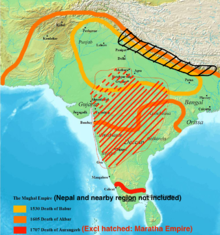
Expansion of the Mughal Empire from 1526 to 1700.
The empire went into decline thereafter. The Mughals suffered several blows due to invasions from
Marathas and
Afghans. During the decline of the Mughal Empire, several smaller states rose to fill the power vacuum and themselves were contributing factors to the decline. In 1737, the Maratha general
Bajirao of the Maratha Empire invaded and plundered Delhi. Under the general Amir Khan Umrao Al Udat, the Mughal Emperor sent 8,000 troops to drive away the 5,000 Maratha cavalry soldiers. Baji Rao, however, easily routed the novice Mughal general and the rest of the imperial Mughal army fled. In 1737, in the final defeat of Mughal Empire, the commander-in-chief of the Mughal Army, Nizam-ul-mulk, was routed at Bhopal by the Maratha army. This essentially brought an end to the Mughal Empire. In 1739,
Nader Shah, emperor of Iran, defeated the Mughal army at the
Battle of Karnal.
[291] After this victory, Nader captured and sacked Delhi, carrying away many treasures, including the
Peacock Throne.
[292] The
Mughal dynasty was reduced to puppet rulers by 1757. The remnants of the Mughal dynasty were finally defeated during the
Indian Rebellion of 1857, also called the 1857 War of Independence, and the remains of the empire were formally taken over by the British while the
Government of India Act 1858 let the
British Crown assume direct control of India in the form of the new
British Raj.
The Mughals were perhaps the richest single dynasty to have ever existed. During the Mughal era, the dominant political forces consisted of the Mughal Empire and its tributaries and, later on, the rising successor states – including the Maratha Empire – which fought an increasingly weak Mughal dynasty. The Mughals, while often employing brutal tactics to subjugate their empire, had a policy of integration with Indian culture, which is what made them successful where the short-lived Sultanates of Delhi had failed. This period marked vast social change in the subcontinent as the Hindu majority were ruled over by the Mughal emperors, most of whom showed religious tolerance, liberally patronising Hindu culture. The famous emperor Akbar, who was the grandson of Babar, tried to establish a good relationship with the Hindus. However, later emperors such as
Aurangazeb tried to establish complete Muslim dominance, and as a result several historical temples were destroyed during this period and taxes imposed on non-Muslims. Akbar declared "Amari" or non-killing of animals in the holy days of Jainism. He rolled back the
jizya tax for non-Muslims. The Mughal emperors married local royalty, allied themselves with local
maharajas, and attempted to fuse their Turko-Persian culture with ancient Indian styles, creating a unique
Indo-Saracenic architecture. It was the erosion of this tradition coupled with increased brutality and centralisation that played a large part in the dynasty's downfall after Aurangzeb, who unlike previous emperors, imposed relatively non-pluralistic policies on the general population, which often inflamed the majority Hindu population.
Maratha Empire

Political map of Indian Subcontinent in 1758. The
Maratha Empire (orange)was the last Hindu empire of India.

Shaniwarwada palace fort in
Pune, it was the seat of the Peshwa rulers of the Maratha Empire until 1818.
The early 18th century saw the rise of Maratha suzerainty over the Indian Subcontinent. Under the Peshwas, the
Maratha Empire consolidated and ruled over much of the Subcontinent. The
Marathas are credited to a large extent for ending the
Mughal rule in India.
[293][294][295]
Historian K.K. Datta wrote about Bajirao I:
He may very well be regarded as the second founder of the Maratha Empire.
[297]
By the early 18th century, the Maratha Kingdom had transformed itself into the Maratha Empire under the rule of the
Peshwas (prime ministers). In 1737, the Marathas defeated a Mughal army in their capital, Delhi itself in
Battle of Delhi (1737). The Marathas continued
their military campaigns against
Mughals,
Nizam,
Nawab of Bengal and Durrani Empire to further extend their boundaries.
Gordon explained how the Maratha systematically took control over new regions. They would start with annual raids, followed by collecting ransom from villages and towns while the declining Mughal Empire retained nominal control and finally taking over the region. He explained it with the example of Malwa region. Marathas built an efficient system of public administration known for its attention to detail. It succeeded in raising revenue in districts that recovered from years of raids, up to levels previously enjoyed by the Mughals. For example, the cornerstone of the Maratha rule in Malwa rested on the 60 or so local tax collectors who advanced the Maratha ruler
Peshwa a portion of their district revenues at interest.
[298] By 1760, the domain of the Marathas stretched across practically the entire subcontinent.
[299]
India contains no more than two great powers, British and Mahratta, and every other state acknowledges the influence of one or the other. Every inch that we recede will be occupied by them.
[302][303]
The Marathas also developed a potent
navy circa 1660s, which at its peak, dominated the territorial waters of the western coast of India from
Mumbai to
Savantwadi.
[304] For a brief period, the Maratha Navy also established its base at the
Andaman Islands in the
Bay of Bengal.
[305] It would engage in attacking the
British,
Portuguese,
Dutch, and
SiddiNaval ships and kept a check on their naval ambitions. The Maratha Navy dominated till around the 1730s, was in a state of decline by the 1770s, and ceased to exist by 1818.
[306]
Sikh Empire

Harmandir Sahib or
The Golden Temple is culturally the most significant place of worship for the
Sikhs.
Maharaja Ranjit Singh consolidated many parts of northern India into an empire. He primarily used his highly disciplined
Sikh Khalsa Army that he trained and equipped with modern military technologies and technique. Ranjit Singh proved himself to be a master strategist and selected well qualified generals for his army. He continuously defeated the Afghan armies and successfully ended the
Afghan-Sikh Wars. In stages, he added the central Punjab, the provinces of Multan and Kashmir, the Peshawar Valley, and the Derajat to his empire.
[307][308]
At its peak, in the 19th century, the empire extended from the
Khyber Pass in the west, to
Kashmir in the north, to
Sindh in the south, running along Sutlej river to
Himachal in the east. After the death of Ranjit Singh, the empire weakened, leading to the conflict with the British East India Company. The hard-fought
first Anglo-Sikh war and
second Anglo-Sikh war marked the downfall of the Sikh Empire; making it among the last areas of the Indian subcontinent to be conquered by the British.
Other kingdoms
There were several other kingdoms which ruled over parts of India in the later medieval period prior to the British occupation. However, most of them were bound to pay regular tribute to the
Marathas.
[299] The rule of
Wodeyar dynasty which established the
Kingdom of Mysore in southern India in around 1400 CE by was interrupted by
Hyder Ali and his son
Tipu Sultan in the later half of the 18th century. Under their rule, Mysore fought a
series of wars sometimes against the combined forces of the British and
Marathas, but mostly against the British, with Mysore receiving some aid or promise of aid from the French.
The
Nawabs of Bengal had become the de facto rulers of
Bengal following the decline of Mughal Empire. However, their rule was interrupted by Marathas who carried
six expeditions in Bengal from 1741 to 1748 as a result of which Bengal became a tributary state of Marathas.
The 18th century saw the whole of
Rajputana virtually subdued by the Marathas. The
Second Anglo-Maratha War distracted the
Marathas from 1807 to 1809, but afterwards
Maratha domination of Rajputana resumed. In 1817, the British went to war with the
Pindaris, raiders who were based in Maratha territory, which quickly became the
Third Anglo-Maratha War, and the British government offered its protection to the Rajput rulers from the Pindaris and the Marathas. By the end of 1818 similar treaties had been executed between the other Rajput states and Britain. The Maratha
Sindhia ruler of
Gwalior gave up the district of
Ajmer-Merwara to the British, and Maratha influence in Rajasthan came to an end. Most of the Rajput princes remained loyal to Britain in the
Revolt of 1857, and few political changes were made in Rajputana until Indian independence in 1947. The
Rajputana Agency contained more than 20 princely states, most notable being
Udaipur State,
Jaipur State,
Bikaner State and
Jodhpur State.
Around the 18th century, the modern state of Nepal was formed by
Gurkha rulers.
Beginning of European explorations and establishment of Colonialism
Western explorers and traders
In 1498, a Portuguese fleet under
Vasco da Gama successfully discovered a new sea route from Europe to India, which paved the way for direct Indo-European commerce. The Portuguese soon set up trading posts in
Goa,
Daman,
Diu and
Bombay. Goa became the main Portuguese base until it was
annexed by India in 1961.
[311]
A disaster of the first magnitude for the Dutch, the
battle of Colachel shattered for all time their dream of the conquest of Kerala.
The
British—who set up a trading post in the west coast port of
Surat in 1619—and the French. The internal conflicts among Indian kingdoms gave opportunities to the European traders to gradually establish political influence and appropriate lands. Although these continental European powers controlled various coastal regions of southern and eastern India during the ensuing century, they eventually lost all their territories in India to the British, with the exception of the French outposts of
Pondichéry and
Chandernagore,
[314][315] and the Portuguese colonies of
Goa,
Daman and Diu.
[316]
Expansion of the British East India Company rule in India
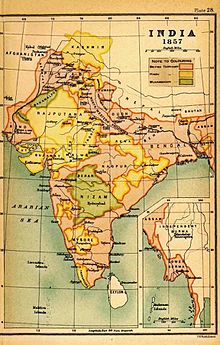
Map of India in 1857 at the end of Company rule.
The
Nawab of Bengal Siraj Ud Daulah, the
de facto ruler of the Bengal province, opposed British attempts to use these permits. This led to the
Battle of Plassey on 23 June 1757, in which the
Bengal Army of the East India Company, led by
Robert Clive, defeated the French-supported Nawab's forces. This was the first real political foothold with territorial implications that the British acquired in India. Clive was appointed by the company as its first 'Governor of Bengal' in 1757.
[319] This was combined with British victories over the French at
Madras,
Wandiwash and
Pondichéry that, along with wider
British successes during the Seven Years' War, reduced French influence in India. The British East India Company extended its control over the whole of Bengal. After the
Battle of Buxar in 1764, the company acquired the rights of administration in Bengal from
de jure Mughal Emperor
Shah Alam II; this marked the beginning of its formal rule, which within the next century engulfed most of India.
[320] The East India Company monopolised the trade of Bengal. They introduced a land taxation system called the
Permanent Settlement which introduced a
feudal-like structure in Bengal, often with
zamindars set in place.
After the turn of the 19th century, Governor-General
Wellesley began what became two decades of accelerated expansion of Company territories.
[322] This was achieved either by
subsidiary alliances between the Company and local rulers or by direct military annexation. The subsidiary alliances created the
princely states or
native states of the Hindu
maharajas and the Muslim
nawabs.
By the 1850s, the East India Company controlled most of the Indian sub-continent, which included present-day Pakistan and Bangladesh also. Their policy was sometimes summed up as
Divide and Rule, taking advantage of the enmity festering between various princely states and social and religious groups.
[323]
Indian indenture system
The Indian indenture system was an ongoing system of indenture, a form of debt bondage, by which 3.5 million Indians were transported to various colonies of European powers to provide labour for the (mainly sugar) plantations. It started from the end of slavery in 1833 and continued until 1920. This resulted in the development of large
Indian diaspora, which spread from the Indian Ocean (i.e.
Réunion and
Mauritius) to Pacific Ocean (i.e.
Fiji), as well as the growth of
Indo-Caribbean and
Indo-African population.
Modern period and Independence (after c. 1850)
The rebellion of 1857 and its consequences

Attack of the mutineers on the Redan Battery at Lucknow, 30 July 1857.
The Indian rebellion of 1857 was a large-scale rebellion by soldiers employed by the British East India in northern and central India against the Company's rule. The rebels were disorganised, had differing goals, and were poorly equipped, led, and trained, and had no outside support or funding. They were brutally suppressed and the British government took control of the Company and eliminated many of the grievances that caused it. The government also was determined to keep full control so that no rebellion of such size would ever happen again.
[324]
In the aftermath, all power was transferred from the East India Company to the
British Crown, which began to administer most of India as a number of provinces. The Crown controlled the Company's lands directly and had considerable indirect influence over the rest of India, which consisted of the
Princely states ruled by local royal families. There were officially 565 princely states in 1947, but only 21 had actual state governments, and only three were large (Mysore, Hyderabad and Kashmir). They were absorbed into the independent nation in 1947–48.
[325]
British Raj (c. 1858–1947)
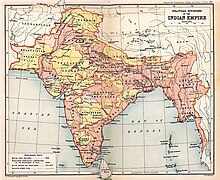
The British Indian Empire at its greatest extent (in a map of 1909). The
princely states under British suzerainty are in yellow.
After 1857, the colonial government strengthened and expanded its infrastructure via the court system, legal procedures, and statutes. The
Indian Penal Code came into being.
[326] In education,
Thomas Babington Macaulay had made schooling a priority for the Raj in his famous minute of February 1835 and succeeded in implementing the use of English as the medium of instruction. By 1890 some 60,000 Indians had matriculated.
[327] The Indian economy grew at about 1% per year from 1880 to 1920, and the population also grew at 1%. However, from 1910s Indian private industry began to grow significantly. India built a modern railway system in the late 19th century which was the fourth largest in the world.
[328] The British Raj invested heavily in infrastructure, including canals and irrigation systems in addition to railways, telegraphy, roads and ports.
[329]However, historians have been bitterly divided on issues of economic history, with the Nationalist school arguing that India was poorer at the end of British rule than at the beginning and that impoverishment occurred because of the British.
[330] of the provincial executive councils as well as the Viceroy's executive council. The Imperial Legislative Council was enlarged from 25 to 60 members and separate communal representation for Muslims was established in a dramatic step towards representative and responsible government.[331] Several socio-religious organisations came into being at that time. Muslims set up the All India Muslim League in 1906. It was not a mass party but was designed to protect the interests of the aristocratic Muslims. It was internally divided by conflicting loyalties to Islam, the British, and India, and by distrust of Hindus.[332] The Akhil Bharatiya Hindu Mahasabha and Rashtriya Swayamsevak Sangh (RSS) sought to represent Hindu interests though the later always claimed it to be a "cultural" organisation.[333] Sikhs founded the Shiromani Akali Dal in 1920.[334] However, the largest and oldest political party Indian National Congress, founded in 1885, is perceived to have attempted to keep a distance from the socio-religious movements and identity politics.[335]
of the provincial executive councils as well as the Viceroy's executive council. The Imperial Legislative Council was enlarged from 25 to 60 members and separate communal representation for Muslims was established in a dramatic step towards representative and responsible government.[331] Several socio-religious organisations came into being at that time. Muslims set up the All India Muslim League in 1906. It was not a mass party but was designed to protect the interests of the aristocratic Muslims. It was internally divided by conflicting loyalties to Islam, the British, and India, and by distrust of Hindus.[332] The Akhil Bharatiya Hindu Mahasabha and Rashtriya Swayamsevak Sangh (RSS) sought to represent Hindu interests though the later always claimed it to be a "cultural" organisation.[333] Sikhs founded the Shiromani Akali Dal in 1920.[334] However, the largest and oldest political party Indian National Congress, founded in 1885, is perceived to have attempted to keep a distance from the socio-religious movements and identity politics.[335]
Hindu Renaissance
The Hindu Renaissance refers to a social reform movement during the nineteenth and early twentieth centuries in the
Bengal region of British India during the period of
British ruledominated by English educated
Bengali Hindus. The
Bengal Renaissance can be said to have started with
Raja Ram Mohan Roy (1772–1833) and ended with
Rabindranath Tagore (1861–1941), although many stalwarts thereafter continued to embody particular aspects of the unique intellectual and creative output of the region.
[336] Nineteenth century Bengal was a unique blend of religious and social reformers, scholars, literary giants, journalists, patriotic orators, and scientists, all merging to form the image of a renaissance, and marked the transition from the 'medieval' to the 'modern'.
[337]
During this period, Bengal witnessed an
intellectual awakening that is in some way similar to the
Renaissance. This movement questioned existing orthodoxies, particularly with respect to
WOMEN
, marriage, the
dowry system, the
caste system, and religion. One of the earliest
social movements that emerged during this time was the
Young Bengalmovement, which espoused
rationalism and
atheism as the common denominators of civil conduct among upper caste educated Hindus. It played an important role in reawakening Indian minds and intellect across the sub-continent.
Famines
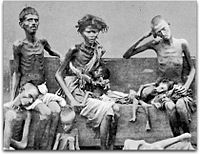
Victims of the
Great Famine of 1876–78 in
British India, pictured in 1877. The famine ultimately covered an area of 670,000 square kilometres (257,000 sq mi) and caused distress to a population totalling 58,500,000. The death toll from this famine is estimated to be in the range of 5.5 million people.
[338]
During the British Raj,
famines in India, often attributed to failed policies of British colonial government, were some of the worst ever recorded, including the
Great Famine of 1876–78 in which 6.1 million to 10.3 million people died
[339] and the
Indian famine of 1899–1900 in which 1.25 to 10 million people died.
[340] The
Third Plague Pandemic in the mid-19th century killed 10 million people in India.
[341] Despite persistent diseases and famines, the population of the Indian subcontinent, which stood at about 125 million in 1750, had reached 389 million by 1941.
[342]
The Indian independence movement
The numbers of British in India were small, yet they were able to rule two-thirds of the subcontinent directly and exercise considerable leverage over the
princely states that accounted for the remaining one-third of the area.
One of the most important events of the 19th century was the rise of Indian nationalism,
[345] leading Indians to seek first "self-rule" and later "complete independence". However, historians are divided over the causes of its rise. Probable reasons include a "clash of interests of the Indian people with British interests",
[345] "racial discriminations",
[346] "the revelation of India's past",
[347] "inter-linking of the new social groups in different regions",
[348] and Indians coming in close contact with "European education".
The first step toward Indian self-rule was the appointment of
councillors to advise the British
viceroy in 1861 and the first Indian was appointed in 1909. Provincial Councils with Indian members were also set up. The councillors' participation was subsequently widened into legislative councils. The British built a large
British Indian Army, with the senior officers all British and many of the troops from small minority groups such as
Gurkhas from Nepal and
Sikhs.
[349] The civil service was increasingly filled with natives at the lower levels, with the British holding the more senior positions.
[350]
Bal Gangadhar Tilak, an Indian nationalist leader, declared
Swaraj as the destiny of the nation. His popular sentence "Swaraj is my birthright, and I shall have it"
[351] became the source of inspiration for Indians. Tilak was backed by rising public leaders like
Bipin Chandra Pal and
Lala Lajpat Rai, who held the same point of
VIEW
. Under them, India's three big provinces –
Maharashtra,
Bengal and
Punjab, India shaped the demand of the people and India's nationalism. In 1907, the Congress was split into two factions: The radicals, led by Tilak, advocated civil agitation and direct revolution to overthrow the British Empire and the abandonment of all things British. The moderates, led by leaders like
Dadabhai Naoroji and
Gopal Krishna Gokhale, on the other hand wanted reform within the framework of British rule.
[352]
The British themselves adopted a "carrot and stick" approach in recognition of India's support during the First World War and in response to renewed nationalist demands. The means of achieving the proposed measure were later enshrined in the
Government of India Act 1919, which introduced the principle of a dual mode of administration, or diarchy, in which elected Indian legislators and appointed British officials shared power.
[353]
World War II
During the Second World War (1939–1945),
India was controlled by the United Kingdom, with the British holding territories in India including over five hundred autonomous
Princely States;
British India officially declared war on
Nazi Germany in September 1939.
[354] The British Raj, as part of the
Allied Nations, sent over two and a half million volunteer soldiers to fight under British command against the
Axis powers. Additionally, several Indian Princely States provided large donations to support the Allied campaign during the War. India also provided the base for American operations in support of China in the
China Burma India Theatre.
The
Indian National Congress, led by
Mohandas Karamchand Gandhi,
Sardar Vallabhbhai Patel and
Maulana Azad, denounced Nazi Germany but would not fight it or anyone else until India was independent. Congress launched the
Quit India Movement in August 1942, refusing to co-operate in any way with the government until independence was granted. The government was ready for this move. It immediately arrested over 60,000 national and local Congress leaders, and then moved to suppress the violent reaction of Congress supporters. Key leaders were kept in prison until June 1945, although Gandhi was released in May 1944 because of his health. Congress, with its leaders incommunicado, played little role on the home front. The
Muslim League rejected the Quit India movement and worked closely with the Raj authorities.
Subhas Chandra Bose (also called Netaji) broke with Congress and tried to form a military alliance with Germany or Japan to gain independence. Japan helped him set up the
Indian National Army (INA) which fought under Japanese direction, mostly in Burma. Bose also headed the
Provisional Government of Free India, a government-in-exile based in Singapore. It controlled no Indian territory and was used only to raise troops for Japan.
After World War II (c. 1946–1947)
In January 1946, a number of mutinies broke out in the armed services, starting with that of RAF servicemen frustrated with their slow repatriation to Britain. The mutinies came to a head with
mutiny of the Royal Indian Navy in
Bombay in February 1946, followed by others in
Calcutta,
Madras, and
Karachi. Although the mutinies were rapidly suppressed, they had the effect of spurring the
new Labour government in Britain to action. Also in early 1946, new elections were called in India and in eight of the eleven provinces Congress candidates won.
Late in 1946, the Labour government decided to end British rule of India, and in early 1947 Britain announced its intention of transferring power no later than June 1948 and participating in the formation of an
interim government.
Along with the desire for independence, tensions between Hindus and Muslims had also been developing over the years. The Muslims had always been a minority within the subcontinent, and the prospect of an exclusively Hindu government made them wary of independence; they were as inclined to mistrust Hindu rule as they were to resist the foreign Raj, although Gandhi called for unity between the two groups in an astonishing display of leadership.

Dead and wounded after the 'Direct Action Day' which developed into pitched battles as
Muslim and
Hindu mobs rioted across
Calcuttain 1946, the year before independence.
Muslim League leader
Muhammad Ali Jinnah proclaimed 16 August 1946 as
Direct Action Day, with the stated goal of highlighting, peacefully, the demand for a Muslim homeland in British India, which resulted in the outbreak of the cycle of violence that would be later called the "Great Calcutta Killing of August 1946". The communal violence spread to
Bihar(where Muslims were attacked by Hindus), to
Noakhali in Bengal (where Hindus were targeted by Muslims), in
Garhmukteshwar in the
United Provinces (where Muslims were attacked by Hindus), and on to
Rawalpindi in March 1947 in which Hindus were attacked or driven out by Muslims.
Independence and partition (c. 1947–present)

An old
Sikh man carrying his wife. Over 10 million people were uprooted from their homeland and travelled on foot, bullock carts and trains to their promised new home.
The
British Indian territories gained independence in 1947, after being
partitioned into the
Union of India and
Dominion of Pakistan. Following the controversial division of pre-partition
Punjab and
Bengal, rioting broke out between Sikhs, Hindus and Muslims in these provinces and spread to several other parts of India, leaving some 500,000 dead.
[355] Also, this period saw one of the largest mass migrations ever recorded in modern history, with a total of 12 million Hindus, Sikhs and Muslims moving between the newly created nations of India and Pakistan (which gained independence on 15 and 14 August 1947 respectively).
[355] In 1971,
Bangladesh, formerly
East Pakistan and
East Bengal, seceded from Pakistan.
Historiography
Historiography is the study of the history and methodology of the discipline of history. The term historiography also denotes a body of historical work on a specialised topic. In recent decades there have been four main schools of historiography regarding India: Cambridge, Nationalist, Marxist, and subaltern. The once common "Orientalist" approach, with its image of a sensuous, inscrutable, and wholly spiritual India, has died out in serious scholarship.
[356]
The "Cambridge School", led by Anil Seal,
[357] Gordon Johnson,
[358] Richard Gordon, and David A. Washbrook,
[359] downplays ideology.
[360] However, this school of historiography is criticised for western bias or
Eurocentrism.
[361]
The Nationalist school has focused on Congress, Gandhi, Nehru and high level politics. It highlighted the Mutiny of 1857 as a war of liberation, and Gandhi's 'Quit India' begun in 1942, as defining historical events. This school of historiography has received criticism for
Elitism.
[362]
The Marxists have focused on studies of economic development, landownership, and class conflict in precolonial India and of deindustrialisation during the colonial period. The Marxists portrayed Gandhi's movement as a device of the bourgeois elite to harness popular, potentially revolutionary forces for its own ends. Again, the Marxists are accused of being "too much" ideologically influenced.
[363]
The "subaltern school", was begun in the 1980s by
Ranajit Guha and
Gyan Prakash.
[364] It focuses attention away from the elites and politicians to "history from below", looking at the peasants using folklore, poetry, riddles, proverbs, songs, oral history and methods inspired by anthropology. It focuses on the colonial era before 1947 and typically emphasises caste and downplays class, to the annoyance of the Marxist school.
[365]
More recently, Hindu nationalists have created a version of history to support their demands for
"Hindutva" ("Hinduness") in Indian society. This school of thought is still in the process of development.
[366] In March 2012,
Diana L. Eck, professor of Comparative Religion and Indian Studies at
Harvard University, authored in her
BOOK
"India: A Sacred Geography", that idea of India dates to a much earlier time than the British or the Mughals and it wasn't just a cluster of regional identities and it wasn't ethnic or racial.
[367][368][369] [370]
 , distribution, and control—and brings to life all manner of technology.
, distribution, and control—and brings to life all manner of technology. of expertise needed to support it.
of expertise needed to support it. to ultimately solve the complex challenges of modernizing global power infrastructures.
to ultimately solve the complex challenges of modernizing global power infrastructures. the sustainability of traditional energy sources.
the sustainability of traditional energy sources. at any given time becomes important for keeping the system stable. But that’s difficult in a system that incorporates significant amounts of solar or wind energy, which can vary unpredictably when clouds roll in or the breeze dies.
at any given time becomes important for keeping the system stable. But that’s difficult in a system that incorporates significant amounts of solar or wind energy, which can vary unpredictably when clouds roll in or the breeze dies. and selling power, complexities in demand response—there are just many more pieces to the system,” Snyder says. “They’re all good, but they introduce new risks and opportunities for things to go wrong.”
and selling power, complexities in demand response—there are just many more pieces to the system,” Snyder says. “They’re all good, but they introduce new risks and opportunities for things to go wrong.” constraints.
constraints. engineering, studies control and optimization of microgrids and power electronic systems. His advanced experimental platform, developed with meaningful contributions from his post-docs and students, facilitates hardware experimentation to test a wide range of algorithms for microgrids, smart grid, and the so-called “energy Internet.”
engineering, studies control and optimization of microgrids and power electronic systems. His advanced experimental platform, developed with meaningful contributions from his post-docs and students, facilitates hardware experimentation to test a wide range of algorithms for microgrids, smart grid, and the so-called “energy Internet.” in fluid dynamics.
in fluid dynamics. fuels such as water-derived hydrogen isotopes and lithium.
fuels such as water-derived hydrogen isotopes and lithium. a number of advantages,” says Eugenio Schuster, director of Lehigh’s Plasma Control Laboratory and professor of mechanical engineering and mechanics. “Fuel is abundant, there’s little risk for nuclear accidents, and power generation doesn’t produce long-term radioactive waste or materials that can be dangerous on any number of levels.”
a number of advantages,” says Eugenio Schuster, director of Lehigh’s Plasma Control Laboratory and professor of mechanical engineering and mechanics. “Fuel is abundant, there’s little risk for nuclear accidents, and power generation doesn’t produce long-term radioactive waste or materials that can be dangerous on any number of levels.” .
.






